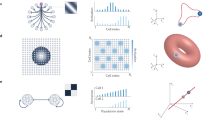Abstract
The saturated attractor analysis, an approach proposed first in [FP] for a comprehensive study of the dynamics of the Linsker model and then successfully applied to the dynamic link model[FT1], is further developed here. By a unified approach to the Hopfield model, the Linsker model and the dynamic link model, three typical models in the field of the neural networks, we show a way to choose the parameters of these dynamics in order to obtain any chosen saturated attractor which is general enough in most applications. We generalize our previous results for the Linsker model and the dynamic link model with the clipping function to the case of the sigmoid like function. Our results allow us for the first time to understand the underlying mechanism among these models and thus to furnish a useful guidance in the further possible applications.
Preview
Unable to display preview. Download preview PDF.
Similar content being viewed by others
References
Antonucci, M. & Tirozzi, B. & Yarunin, N.D. & Dotsenko, U.S. (1994), Numerical Simulation of Neural Networks with Translation and Rotation Invariant Pattern Recognition, Inter. Jour. of Modern Physics B, vol. 8, nos. 11 & 12, pp. 1529–1541.
Feng, J. & Pan, H. (1993), Analysis of Linsker-type Hebbian Learning: Rigorous Results, Proc. 1993 IEEE Int. Conf. on Neural Networks — San Francisco Vol. III, (Piscataway, NJ: IEEE) pp. 1516–1521.
Feng, J. & Pan, H. & Roychowdhury, V. P.(1995), A Rigorous analysis of Linsker's Hebbian learning network, to appear in Advances of Neural Information Processing Systems, Vol.6 (NIP*S 94).
Feng, J. F. & Qian, M. P. (1993), Two-Stage Annealing in Retrieving Memories I, In: Badrikian, A.; Meyer P-A, and Yan, J-A (ed.), Probability and Statistics, Singapore: World Scientific, pp. 149–176.
Feng, J. & Tirozzi, B.(1995), A Discrete Version of the dynamic link model, to appear in Neural Computation.
Feng, J. & Tirozzi, B.(1994), An analysis of the dynamics with the sigmoid like function, preprint.
Konen, W. & Maurer, T. & von der Malsburg, C. (1994), A fast dynamic link matching algorithm for invariant patlern recognition, Neural Network, Vol. 7, Nos, 6/7, pp. 1019–1030.
Linsker, R. (1986), from Basic Network Principle to Neural Architecture (series), Proc. Natl. Acad. Sci. USA, 83, 7508–7512, 8390–8394, 8779–8783.
von der Malsberg, C. (1995), Network self-organization in the ontogenesis of the mammalian visual system, An Introduction to Neural and Electronic Networks, Second Edition, S.F. Zornetzer, J. Davis and C. Lau, Eds. (Academic Press).
Author information
Authors and Affiliations
Editor information
Rights and permissions
Copyright information
© 1995 Springer-Verlag Berlin Heidelberg
About this paper
Cite this paper
Feng, J., Tirozzi, B. (1995). An application of the saturated attractor analysis to three typical models. In: Mira, J., Sandoval, F. (eds) From Natural to Artificial Neural Computation. IWANN 1995. Lecture Notes in Computer Science, vol 930. Springer, Berlin, Heidelberg. https://doi.org/10.1007/3-540-59497-3_196
Download citation
DOI: https://doi.org/10.1007/3-540-59497-3_196
Published:
Publisher Name: Springer, Berlin, Heidelberg
Print ISBN: 978-3-540-59497-0
Online ISBN: 978-3-540-49288-7
eBook Packages: Springer Book Archive




